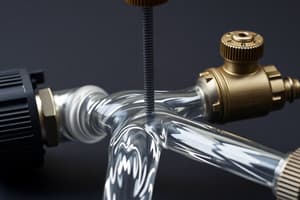Podcast
Questions and Answers
What is the primary purpose of measuring flow in a pipeline?
What is the primary purpose of measuring flow in a pipeline?
- To ensure maximum pressure
- To increase fluid viscosity
- To reduce fluid velocity
- To maintain material balance (correct)
Which of the following flow expressions is considered the most accurate?
Which of the following flow expressions is considered the most accurate?
- Mass (pounds) (correct)
- Velocity (cubic feet per second)
- Pressure (pascals)
- Volumetric (gallons and barrels)
Which flow measuring device is the most common for creating differential pressure?
Which flow measuring device is the most common for creating differential pressure?
- Rotameter
- Pitot tube
- Orifice (correct)
- Venturi
How does Bernoulli’s Principle describe the relationship between fluid velocity and pressure?
How does Bernoulli’s Principle describe the relationship between fluid velocity and pressure?
Which device minimizes pressure loss while creating a pressure drop in fluid flow?
Which device minimizes pressure loss while creating a pressure drop in fluid flow?
In which application are flow nozzles particularly effective?
In which application are flow nozzles particularly effective?
What configuration does a Pitot tube use to measure flow?
What configuration does a Pitot tube use to measure flow?
What principle does a Coriolis mass flow meter rely on to measure mass flow?
What principle does a Coriolis mass flow meter rely on to measure mass flow?
Which flow measuring device is primarily affected by gravity and must be installed vertically?
Which flow measuring device is primarily affected by gravity and must be installed vertically?
Gas flow rates are commonly expressed in which unit?
Gas flow rates are commonly expressed in which unit?
Flashcards are hidden until you start studying
Study Notes
Flow
- Flow measures the quantity of fluid moving through a pipeline.
- Important for material balance, ensuring product in equals product out.
- Expressed in terms of velocity, volume, and mass.
- Velocity is usually measured in cubic feet per second but not commonly used.
- Volume is measured in gallons and barrels.
- Mass is the most accurate measurement and is expressed in pounds.
- Bernoulli's Principle states that as fluid velocity increases, pressure within the fluid decreases.
- An orifice plate, in conjunction with a delta p transmitter, is the most common method used in plants to determine flow rates.
- The high side of the transmitter is connected upstream of the orifice plate, while the low side is connected downstream.
- Flow always travels from high pressure to low pressure.
- The larger the differential pressure across the orifice plate, the greater the flow rate.
- Gas flow rates are expressed in SCF (standard cubic feet).
- Fluid flow rates are expressed in GPM, GPH, GPD, BPM, BPH, and BPD.
- Steam flows (or mass flows) are measured in pounds.
- Laminar flow is smooth and predictable.
- Turbulent flow is characterized by erratic and unpredictable movement caused by high velocity or obstructions.
Flow Sensing & Measuring Devices
- Orifice is the most common device for creating differential pressure. It's installed between orifice flanges with the beveled side facing downstream. Flow is turbulent on the downstream side. The most common type is concentric, with a hole in the center.
- Venturi creates a pressure drop but minimizes pressure loss. It is more expensive than an orifice but provides greater accuracy. Flow is smooth on the inlet and outlet.
- Flow Nozzle is similar to an orifice on the inlet and a venturi on the outlet. It's suitable for slurry applications.
- Pitot tube is another D/P device in an “L” shape, facing the flow. The highest pressure is at the center of the pipe, while the lower pressure is near the outer wall.
- Annubar has 4 impact points upstream and downstream, taking an average pressure reading.
- Rotameter measures small flows using gravity. Installed vertically, flow enters through the bottom and exits the top. It uses a tapered tube and a float.
- Electromagnetic Meter (Magmeter) measures the electrical conductivity of a conductive liquid.
- Turbine meter measures the RPM of a spinning fan.
- Coriolis is a mass flow meter with an electromagnetic coil that causes tubes to vibrate like a tuning fork. It measures the frequency of vibrations and the temperature of the flowing fluid. It's more accurate than volumetric flow meters.
- D/P transmitter is the most common type, working according to Bernoulli's principle.
- Weir is used in underground sewer trunks, basins, lagoons, ponds, and environmental drains to direct excess water flow over a wall (weir) to safe locations during heavy rains.
- Flapper/Paddlewheel are sight glasses that provide visual evidence of flow, for example, in lube oil circulation or cooling water jacket.
Studying That Suits You
Use AI to generate personalized quizzes and flashcards to suit your learning preferences.




